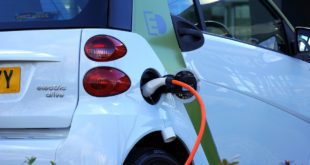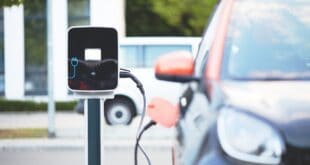Wind energy is an environmentally inert, clean, and inexhaustible source of electric power that, as it turns out, is really just another form of solar energy. The sun creates wind by its uneven heating of the planet’s atmosphere. It’s moderated by the earth’s rotation and irregularities in its surface. The planet’s terrain, water bodies, and vegetation then affect the wind flow patterns. With the invention of wind turbines, we can now harness the wind’s energy and use it instead of purchasing electricity from the utility companies that are derived from non-renewable sources.
The easiest way to understand how wind turbines work is to think of a fan operating in reverse – rather than electricity spinning the blades and thus generating wind, the wind spins the blades, thereby generating electricity.
Breaking it down to it’s simplest components, a wind turbine operates as follows:
the wind turns the blades
the blades spin a shaft
the shaft connects to a generator
the generator produces electricity
To expand on that simplification, the turbine’s blades are connected to a hub that’s mounted atop a turning shaft which runs into a gear transmission box that increases the turning speed which, in turn, is connected to a high speed shaft that cranks the generator. If the wind speeds get too high, a brake is deployed to slow the blades down and prevent damage being done to the system.
There are two basic types of wind turbine:
horizontal axis wind turbines: the kind most commonly in use today and the focus of U.S.
Department of Energy research on wind power, these come in two varieties –
2-blade horizontal axis turbines spin downwind
3-blade horizontal axis turbines spin upwind
vertical axis wind turbines
The size of a wind turbine will influence its power generating capacity, with the smaller windmills that produce under 50 kilowatts being the type most commonly used to power water pumps, telecom dishes, and homes.
In an innovative advancement known as hybrid wind systems, these smaller turbines are also being used in combination with solar (photovoltaic) systems, rechargeable deep-cycle batteries, and diesel generators to provide storable, on-demand power in more remote, off-the-grid places.
In most residential situations, a wind turbine is used as a supplemental source of power in combination with local, on-the-grid, utility power. There is something called a cut-in speed (7-10 miles per hour), below which the wind turbine will cease to provide an output, and the utility grid provides the structure’s power. Above the cut-in speed, the wind turbine kicks in and the grid power supply is proportionately reduced (depending on the structure’s energy draw at the given moment).
If the output produced by the wind turbine exceeds the draw from the structure (and/or storage devices, like batteries), the excess power is then sold back to the pubic utility company. Use of wind energy can reduce a residence’s energy costs by, on average, 50-90%, though these numbers are influenced by a variety of factors and, as such, can fluctuate greatly.
In a typical residence that uses under 10,000 kilowatt hours per year of electric power, a 5-15 kilowatt wind turbine should more than suffice. This type of system can run anywhere from $6,000-$22,000 to install, depending on a variety of factors, including: its size, your intended application, and any service contracts entered into with the manufacturer.
Being that certain situations (such as in the city) make personal wind power use an unviable option, a general rule of thumb is to consider installing your own wind power system if and only if you pay at least 10 cents per kilowatt hour and your location’s average wind speeds exceed 10 miles per hour.
The larger wind turbines have capacities upwards of 50 kilowatts, running these days into the several-megawatt range. These windmills, known as utility scale turbines, can be grouped together and connected to central lines for transmitting and distributing in bulk to the local utility grids that, in turn, sell that power to homes and businesses across the land. These are called wind power plants or wind farms.
 Alternative Energy HQ solar power for homes, wind energy, and bio fuel issues
Alternative Energy HQ solar power for homes, wind energy, and bio fuel issues








